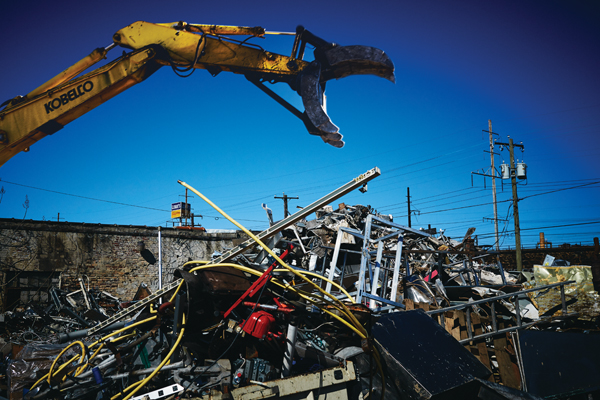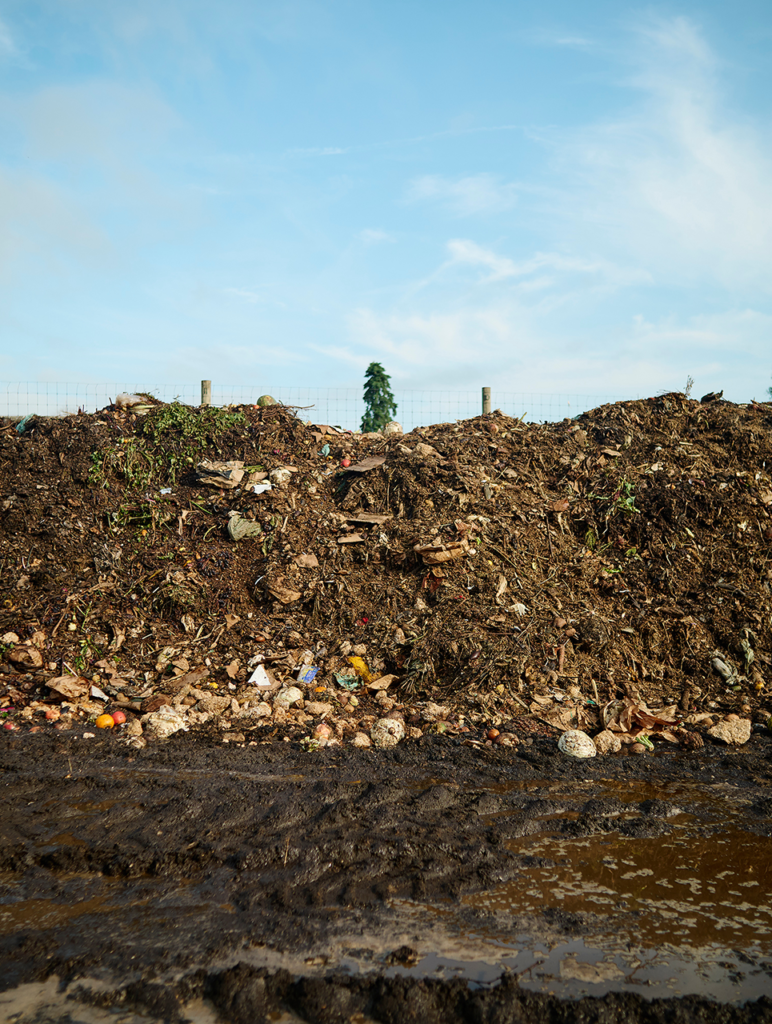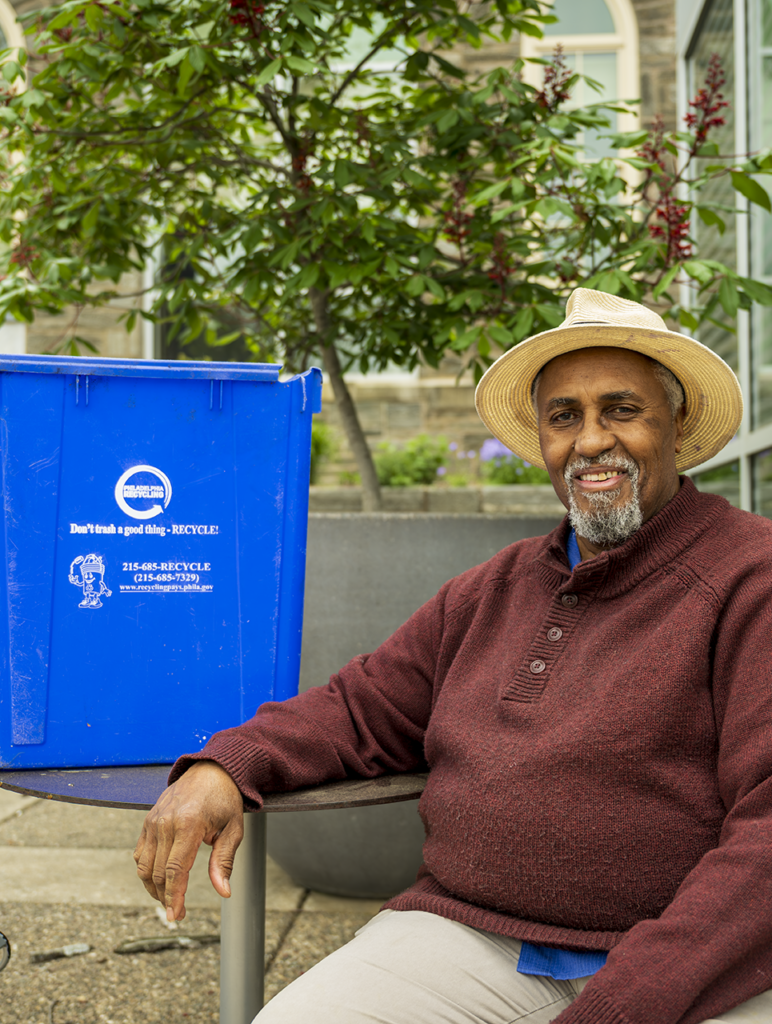Photo by Mark Likosky
The Crucible
by Thomas Parry
It’s below freezing and the wind blasts across a lot in Northeast Philadelphia, but Chris Little doesn’t shiver.
He’s big. Defensive-tackle big. And fast. In a moment he’s around the back of his battle-worn Ford pickup, sorting through a pile of metal set against the wall of the garage. Every weekday he sets out to buy scrap from the city’s auto shops. Brake shoes, bumpers, alternators, anything busted beyond use. Today, he’s begun in the neighborhood of Holmesburg and plans to work his way south, ending at a metal yard in Kensington.
Across the city and outlying areas, scrappers like Little head out early, often before dawn, pushing carts or driving trucks. Rattling through the streets, they collect our discarded metal. By sunset, they’ll sell their gleanings to a metal yard. The payoff goes beyond the cash earned by the individual scrapper. Scrap metal recycling is a salve to the wounds inflicted by our industrial age.
Every bit of copper a scrapper pulls from an old TV left on the sidewalk is one less bit of copper pulled from the earth. Scrap metal recycling staves off mines and their enormous costs in pollution, energy, and in many cases, human misery. Right now, however, the mines are winning.
Across the globe, mines proliferate. They put out “virgin” metals, costly in CO2 and pollution yet cheap in dollars—so cheap that a Philadelphia scrapper can barely hang on.
The hustle and the bubble
From the shop door where Little has arrived for his first stop of the day, a mechanic wearing navy blue coveralls steps out.
“This the man, right here,” he says of Little. “He’s been coming around here a long time.”
They agree on a price and Little peels a few fresh 20s from a roll. The mechanic is about to duck into the shop to make change, but Little tells him to keep it. To stay alive as a scrapper, Little needs to keep his clientele happy. He needs the shops to set aside metal with him in mind. These days, he needs every edge.
The haul in Holmesburg is good. Between this first garage and the next, Little and his cousin Mark collect a dozen rusted brake rotors, Frisbee-sized steel discs that Mark, Little’s sole crew for the day, tosses into a 50-gallon drum bolted to the cargo bed of the pickup. Better still, the first garage had two catalytic converters. The converters, which look like large canteens with a mouth at each end, keep down the toxic pollutants in an automobile’s exhaust. The “catalysts” in this conversion are the precious metals of palladium, rhodium and—best of all—platinum.
Little pays the garage $25 for each converter. The scrapyard will pay $50 or more.
Little leaves Holmesburg and heads south for Tacony. His pickup floats down Frankford Avenue, through the morning glare coming off of the shop windows. It bangs on the seams of the road. Oil grime lines the cargo bed. The tailgate, salvaged from another truck, is gold-colored and bashed in.
“This truck was nice when I got it,” Little says with a smile.
At a garage between I-95 and the rail tracks, Little and Mark get out to inspecta heap of metal pressing down a patch of long grass by a chain-link fence. Little offers the mechanic $90. A motor, a car door and a dozen rotors are in the haul. Mark bends the better part of a rusted-out exhaust system against the asphalt lot and folds it into the cargo bed. The day has shown strong start.
One morning in 1991, when Little was a high school kid in Logan, North Philadelphia, his grandfather took him out scrapping. Little was hooked. For years afterward he rode shotgun with uncles and other scrappers, learning the trade.
“I had one other job in my life, in a nursing home,” he says, “but as soon as I got a truck, I started scrapping full time.”
Little’s trade is knowledge.
It’s a mental map of auto shops that stretches into New Jersey, Delaware and Maryland. It’s an ability to improvise a day’s route. You have to stay away from the neighborhoods that are beat, find the areas no one has picked over and bend the route according to traffic. You have to slip the truck through crowded lots. You have to know the mechanic in charge, get his attention and make a deal without making it a chore. You have to keep them happy.
The trade is knowing what you’re looking at. Little is prepared to drop a grand in cash per day. It’s a gamble, and to make the gamble pay he has to know how much brass lurks inside of an engine’s housing, or that GM catalytic converters are up over Chrysler’s.
Little has to know the yards, their prices, and whether it’s worth the time and gas to cross the city to another that pays more for copper.
There’s no room for error: The margins are thin, and a bad purchase can erase the money he’s made for the day.
“It’s tight out here,” Little says. “I’ve never seen prices this low.”
Out of Tacony and into Bridesburg, Little hits a slump. At two shops in a row, no one answers. At the next, a mechanic with his hands full of keys and a 24-ounce Wawa coffee tells Little he’s got nothing. At the following shop, the garage door flies up and a wild-eyed mechanic shouts, “Naw, man, I’m scrapping my own!”
We pull into a gas station and Little drops $60 on fuel. As the digital numbers tally, Little shows his first signs of doubt. “Man, I hope it’s a good day,” he says. “I hate coming home and telling my wife I didn’t make nothing.”
In under 20 minutes, Little weaves through Frankford, backing down alleys and squeezing through tight streets. Two rusted wheel rims join the cargo bed. As we ease out of the neighborhood, Little slows the truck. He points at a garage door. “Right there,” he says “that was my shop.”
When scrap metal prices peaked in 2012, Little bought a detailing shop.
“See, the sign is still up.”
C and N detailing. C is for Chris and N is for his wife. She ran the shop. “I was out here doing this. I love this.”
After the shop, he bought two water ice trucks and an auto garage. That summer, Little would ride with a four-man crew. In 2012, one man’s scrap operation had created the seed money for three businesses and almost a dozen jobs.
“For six or seven months, it was wonderful. Best summer I ever had.” Those were the flush times, “When the gettin’ was good,” as Little says.
When the gettin’ was good, China wanted metal. For a decade in which its GDP grew 10 percent each year, China wanted metal for new machinery, for consumer goods sold in the U.S. and across the world, for trains, rails and bridges, and for skyscrapers, hundreds of them shooting up in cities from Shanghai to Shenzhen. At its peak of consumption—a bubble from 2011 to 2014—China bought almost half of the steel on the world’s market, according to the World Steel Association.
“They wanted it, and they wanted it at almost any cost,” says Barbara Reck, a metals research scientist at the Yale School of Forestry and Environmental Studies. “In those 10 years [of China’s boom], the prices for raw materials skyrocketed.”
The world’s second-largest economy has since slowed. “China doesn’t want the metal like they used to,” says Chris Little. “If [prices] go any lower,” he says, “I might have to do something else.” He’s already sold the detailing shop, the water ice trucks and the auto garage. He got rid of the BMW he drove when scrap was king. He’s moved out of his house and into a one-bedroom apartment.
“Man,” he says, “I’m selling my rings.”
Up ahead the sun shines off of the El train. We pass beneath its shadow on Kensington Avenue. A pothole rustles the scrap in the cargo bed. Back in the sun, heading for Broad Street, Little reconsiders. Tax refund season is
coming. Refunds bring cars into the shops, and bumpers, rotors and catalytic converters will appear on the asphalt. What’s more, he has his eye on the presidential election. “Once Donald Trump gets in there,” Little says, “he’s gonna start a war, and scrap metal will go way up.”
The slowdown in China has had a major impact on Little’s life. But at the core of the price drop lies a dirtier, more intractable problem: mines.
The mines
In the years of the boom, mining companies made huge capital investments, opening mines to meet the demand. Mining, however, is a slow industry.
“The time between the idea of increasing capacity and actually getting going is a few years,” Reck says. “Some of these mines are just coming online now. Essentially, our capacity is tailored to demand by China five to 10 years ago.”
In a scramble to recoup the investment, mining companies have flooded the market with “virgin” metal, driving prices to historic lows.
Outliers aside, cheap, virgin metal will continue to shape the market, in part because many of the new mines opened in countries where labor and regulatory costs are low. Think Guinea, South Africa, Ukraine, India and China itself. Furthermore, just as a mine is hard to open, it’s tough to close.
“Once you’ve started your new mine,” Reck says, “then you need to run it for one to three decades to get your money back.”
That virgin metal may be cheap in dollars, but it’s costly in CO2 and pollution. In some places, mine workers bear an even greater cost in injury and loss of freedom.
In every metal studied, recycling presents a huge savings in energy, so says a massive 2013 report released by the United Nations Environment Programme. The UNEP report details the obvious; collecting and melting down metal waste is leagues more efficient than opening the earth and processing rocky ore.
With an open pit mine, huge machinery and energy-dense explosives cut and blast the earth’s surface for trucks to haul away. Underground shaft mines, which appear surgical in comparison, require even greater energy. Consider drilling, blasting and clearing a mile-long corridor beneath the earth to convey tons of ore back to the light of day.
Whether by pit or shaft, once the rocky chunks of ore are out, they’re trucked to a grinder that can beat boulders into a grain of “liberation size” particles. To liberate pure metal from the grain, mines apply either heat or chemicals. To melt the metal from the ore requires huge amounts of fossil fuels. To “leach” the metal out, mines may douse the ore in cyanide or sulfuric acid. Whether heated or leached, ore results in leftovers, an often toxic mix called “tailings.”
But that’s not all. There remains the cost of damage to the landscape, the destruction of ecosystems, and the occasionally radioactive and often poisonous metal dust that may have churned into the local soil and contaminated the water. Mining is an ordeal.
Then there’s the human toll.
The abuse of mine workers across the world is a long-standing target of the U.N. International Labour Organization. The ILO has detailed the lives of the more than one million children across the world who spend long hours crawling into pits and tunnels to dig and blast, to hammer in the dark, to set explosives. They handle sulfur, cyanide and mercury as they mine for tin in Indonesia, copper in Mongolia, zinc in Zambia or tungsten in the Democratic Republic of the Congo, where mining profits fuel the warring factions of a civil war. Some of these workers are born into slavery, others are forced into these inhuman conditions later in life. Still others areconned into working and will never be able to leave. From the mouth of the mine, the injustice spreads as young women and girls are pressed into a sex trade that flourishes in and around the camps.
To be sure, global recycling has witnessed abuses. Electronics recycling in India and other countries often poisons workers, many of whom are children, but unlike the ore that’s found in remote areas, away from the presence of law, schools and social services, the source of this scrap lies in our homes, stores and offices. These materials can be recycled here, and American workers who transform it back into a raw material have a far better shot at fairness and safety.
For all of its benefits, though, scrapping is not carbon neutral. Waste metal moves by way of trucks. Yards run excavators and cranes for sorting. Consumer goods such as refrigerators get broken down with power tools. The stripped remains run through shredders, chambers of grinding shafts, blades and hammers that spit out tatters of metal. Electrical currents sort out the shreds. From there, the material is smelted; some items require more work before being smelted, others, such as I-beams, go directly in.
As complex as the task may be, it hardly compares to a mine. UNEP’s report found that recycled aluminum presents a 90 to 97 percent energy savings over its mined counterpart. Steel, on the low end of the spectrum, presents a savings of 60 percent. European Metal Recycling, a corporation with 150 plants across the world, estimates that every year its operations save the atmosphere from 15 million tons of CO2.
Whether the flood of virgin materials will drive down recycling rates worldwide remains to be seen. On the ground in Philadelphia, however, the decline of scrap is felt in the metal yard.
The yard
As Joseph Lombardo Jr. walks his metal yard at 49th Street and Lancaster Avenue, the piles of iron reach over two stories, the cinder block stalls brim with a kaleidoscope of crushed aluminum cans, and bright tangles of stripped copper wire overfill their barrels. But to Lombardo’s eye, the material is low, and he knows why.
He points to a scrapper unloading a white bed frame onto the scale. “See that? That’s light iron. He’ll get a penny a pound,” Lombardo says. Last winter’s price drop has slashed the yard’s intake. “Where a pickup might have gotten $150 a truckload, maybe he’s getting 16, 17 dollars,” Lombardo says. “That killed off 75 percent of the business.”
Metal prices sloped downward throughout the second half of 2014. Then they dropped off a cliff. No one could see the bottom.
“A broker, whose single job is buying and selling scrap, couldn’t give you a price,” Lombardo says. “That’s how fast it was coming down.”
Another illustration: “The metal I bought in the morning was devalued 25 percent by the end of the day. That’s how fast it was coming down.”
The greatest shock for Lombardo came in January 2015. A mill Lombardo had negotiated with three days before sent out a group email to void all sales contracts.
Out on Lombardo’s yard, the ragged pyramids of a once valuable commodity were now near-worthless heaps. He could still truck it to the mill, but a container’s worth of steel might not clear the cost of the driver, gas, tolls, and wear and tear.
“I lost well over a hundred grand,” Lombardo figures, “and that’s chump change compared to a lot of other guys.”
In the past year, not much has changed. Except the way Lombardo has come to look at his yard.
The problem is not too little metal, too few grills, radiators or I-beams. The problem is not enough of everything else.
To survive, Lombardo believes his yard must unwind its heavy dependence on metal.
A yard that can recycle an array of materials can weather the collapse of a single commodity. That’s Lombardo’s thinking, and it’s the strategy behind Revolution Recovery< /a>, a Northeast Philadelphia yard.
When a demo crew drops a container off at the Revolution Recovery lot in Tacony, 80 percent of the debris get recycled: Drywall gets pulverized, the lumber gets chipped, the rubble is crushed, and even ceiling tiles and carpet are repurposed.
The yard transforms building waste into more than 40 commodities. As with metal, some of those commodities have seen price drops, but as Revolution Recovery co-owner Avi Golen confirmed via phone, “The diversity helps.”
Lombardo is more emphatic: “You’ve got to diversify. It’s the future.” His inspiration for a diversified yard, however, came from the past. Specifically, his grandfather. “He recycled everything,” Lombardo says.
James F. Lombardo came to Philadelphia from Italy and got a job working at the Navy Yard as a crane operator. From his perch in the crane, he saw men collecting rags, cardboard and bits of metal, Joe says. James opened his first yard at Second Street and Moyamensing Avenue. From the time Joe was a child he remembers the cranes swinging their “clam buckets,” metal piled up high, the noise, the commotion and the buzz of deals being made.
Joe grew up, as he says, “hanging off the back of a garbage truck.”
In 2011, he bought his own metal yard. The deal was good, but without any cash to spare, Lombardo still needed a truck. A yard that can’t haul can’t sell to a mill, so his wife sent him out with her credit cards. Both cards at their limit bought a 26-foot roll off truck and a couple of containers.
“I’m telling you, it had a million mechanical problems,” Lombardo says. “I spent all day and all night wrenching on this truck to get it up on the road.”
It was a rocky start, but help arrived in the form of favors from friends Joe’s grandfather had made in the industry. “People came out of the woodwork to help,” he says. “Guys kept telling me, ‘I’m doing this for your grandfather. He was a hell of a man,’” Lombardo says. “I did a lot of visiting at the cemetery to thank him, believe me.”
Running a metal yard through the present collapse has been a struggle, but Lombardo insists: “I wouldn’t change a minute of it.”
His dedication, born from a family connection and years spent in the game, jibes with that of Chris Little.
“I love scrapping,” Little said. “It’s been in my family for years. All my uncles, my cousins, all my family scraps. But me, I’ve committed to it.”
As Little and Lombardo see it, they have to endure. Little will endure the days when he comes home with nothing. He’ll grit his teeth when his fingers are mashed by metal in the cold. Lombardo will walk his yard. He’ll check that his scales are true and his contracts sound. He’ll make sure the metal is clean.
As Little says, “It’s got to get better out here.”











This is a lovely article, but it might be nice to see how neighborhoods are affected when a scrapyard (or 3) is located nearby. The drug trade, short dumping, toxic air and ground, and massive amounts of theft are the unromantic, but very real side of scrapyards. Might be a good follow up article.